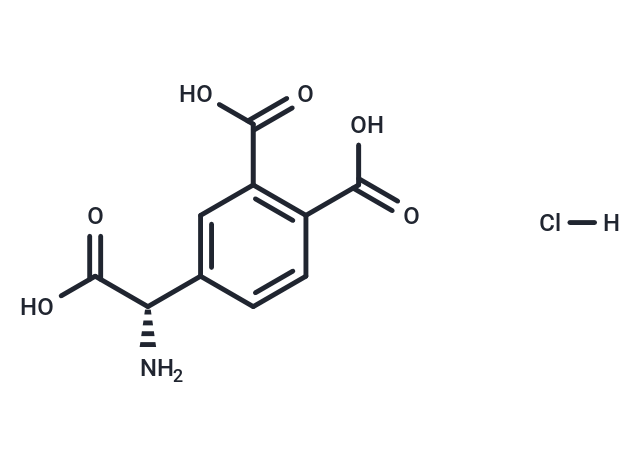Shopping Cart
- Remove All
 Your shopping cart is currently empty
Your shopping cart is currently empty

(S)-3,4-DCPG HCl ((S)-3,4-Dicarboxyphenylglycine HCl) is a selective metabotropic glutamate receptor 8a (mGluR8a) agonist that has an effect on human mGluR8-expressing AV12-664 cells with an EC50 of 31 nM.

| Pack Size | Price | Availability | Quantity |
|---|---|---|---|
| 1 mg | $193 | In Stock | |
| 5 mg | $486 | In Stock | |
| 10 mg | $695 | In Stock | |
| 25 mg | $1,090 | In Stock | |
| 50 mg | $1,490 | In Stock | |
| 100 mg | $1,970 | In Stock | |
| 500 mg | $3,960 | Backorder | |
| 1 mL x 10 mM (in DMSO) | $437 | In Stock |
| Description | (S)-3,4-DCPG HCl ((S)-3,4-Dicarboxyphenylglycine HCl) is a selective metabotropic glutamate receptor 8a (mGluR8a) agonist that has an effect on human mGluR8-expressing AV12-664 cells with an EC50 of 31 nM. |
| Targets&IC50 | mGluR8a (human):31 nM (EC50) |
| In vivo | (S)-3,4-DCPG (3-100 mg/kg, i.p.) maked c-Fos as an indicator of neuronal activity in specific brain regions 2 hours after systemic administration. In wild-type mice, (S)-3,4-DCPG (100 mg/kg) significantly increased c-Fos expression in several stress-related brain regions: paraventricular nucleus of the hypothalamus, central nucleus of the amygdala, lateral parabrachial nucleus and locus coeruleus.[2] |
| Alias | (S)-3,4-Dicarboxyphenylglycine HCl, (S)-3,4-DCPG HCl(201730-11-2 Free base) |
| Molecular Weight | 275.64 |
| Formula | C10H10ClNO6 |
| Smiles | OC(C1=C(C=CC([C@H](N)C(O)=O)=C1)C(O)=O)=O.[H]Cl |
| Relative Density. | no data available |
| Storage | Pure form: -20°C for 3 years | In solvent: -80°C for 1 year | Shipping with blue ice. | |||||||||||||||||||||||||
| Solubility Information | DMSO: 10 mg/mL (36.28 mM), Sonication is recommended. | |||||||||||||||||||||||||
Solution Preparation Table | ||||||||||||||||||||||||||
DMSO
| ||||||||||||||||||||||||||

Copyright © 2015-2025 TargetMol Chemicals Inc. All Rights Reserved.